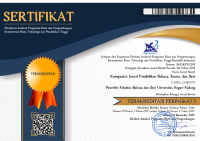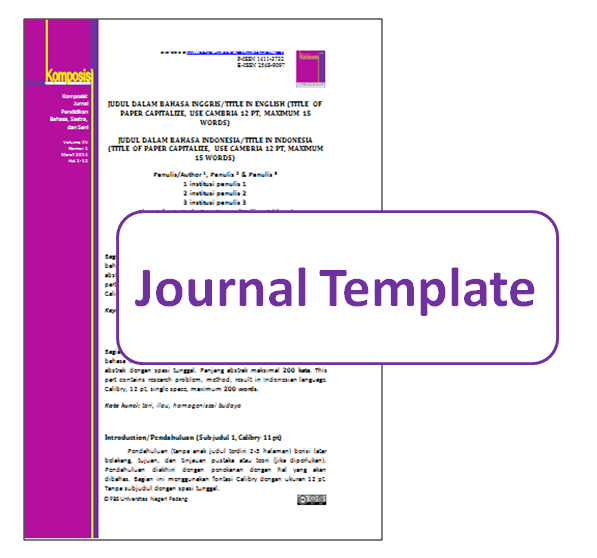MALL IN LEARNING ENGLISH GRAMMAR FOR HIGHER EDUCATION STUDENTS
 ), Nora Fudhla(2), Bayu Hadi Saputro(3),
), Nora Fudhla(2), Bayu Hadi Saputro(3), (1) Universitas Negeri Padang
(2) Universitas Negeri Padang
(3) Universitas Jambi
 Corresponding Author
Corresponding Author
Copyright (c) 2019 Komposisi: Jurnal Pendidikan Bahasa, Sastra, dan Seni
DOI : https://doi.org/10.24036/komposisi.v20i1.102282
Full Text:
 Language : en
Language : en
Abstract
The 21stcentury learning trend with mobile devices has made significant impacts on the educational setting. It promotes students’ autonomous learning attitude to have their own learning setting anytime, anywhere, and in any way as the purpose of lifelong learning. It is also applied to build students’ 21stcentury skills known as 4-Cs; collaboration, communication, critical thinking, and creativity as well as digital literacy. On the other hand, there are some questions and concerns being echoed around the matter of balancing pedagogy and technology on the grammar learning content for university level students. This article is a part of developmental research that focuses on an analysis of the principles and features of mobile technology support tools for learning English grammar in higher education. A questionnaire using online Google form is administered to the 79 students to see their perspective on learning grammar in 21stcentury mode. Further, the data are gathered in qualitative-descriptive method to find the appropriate criteria. This study meets a basic model preference to build a MALL-Based educational app that can support English grammar learning in Universitas Negeri Padang. It can be concluded that the MALL for grammar should cover all teaching-learning elements like sources and assessments.
Keywords
References
Ahmad, K. S., Sudweeks, F., & Armarego, J. (2015). Learning English vocabulary in a Mobile Assisted Language Learning (MALL) environment: A sociocultural study of migrant women. Interdisciplinary Journal of e-Skills and Life Long Learning, 11, 25-45. Retrieved from http://www.ijello.org/Volume11/IJELLv11p025- 045Ahmad1566.pdf
Alismail, H.A. & McGuire, P. (2015). 21st Century Standards and Curriculum: Current Research and Practice. Journal of Education and Practice. 6 (6), 150-155
Baleghizadeh, S and Oladrostam, E. (2011). The Effect of Mobile Assisted Language Learning
(MALL) on Grammatical Accuracy of EFL Students* Special issue: The Internet and
Technology in EFL/ESL.
Chuang, Yung-Ting. 2015. SSCLS: A Smartphone-Supported Collaborative Learning System. Telematics and Informatics. Volume 32, Issue 3, August 2015, Pages 463-474
Fitrawati. 2017. Do Students Need Multimedia Based Grammar 3 Teaching Material?. Linguadidaktika. Vol. 11, No. 1, 2017, pp. 111-122
Ganapathy, M, Shuid M., & Azizan, A.N. (2016). Malaysian ESL Students’ Perceptions on the Usability of a Mobile Application for Grammar Test: A Case Study of ESL Undergraduates in Universiti Sains Malaysia. 3L: The Southeast Asian Journal of English Language Studies. 22 (1), 127-140. DOI: 10.17576/3L-2016-2201-10
Hazaea, A.N. & Alzubi, A.A. (2016). The Effectiveness of Using Mobile on EFL Learners’ Reading Practices in Najran University. Received: February 14, 2016 Accepted: April 2, 2016 Online Published: April 5, 2016 doi: 10.5539/elt.v9n5p8 URL: http://dx.doi.org/10.5539/elt.v9n5p8
Kim, H.S. (2013). Emerging Mobile Apps to Improve English Listening Skills. Multimedia-Assisted Language Learning. 16(2), 11-30
Kivunja, C. (2014). Innovative Pedagogies in Higher Education to Become Effective Teachers of 21st Century Skills: Unpacking the Learning and Innovations Skills Domain of the New Learning Paradigm. International Journal of Higher Education. 3 (4)
Ovilia, R. & Asfina, R. (2017). 21st Century Learning: Is ICT Really Integrated in EFL Classroom or Merely Segregated Outside the Classroom?. EnJourMe Journal. 2 (1), 1-17.
Scott, C.L. (2015). THE FUTURES of LEARNING 3: What kind of pedagogies for the 21st century?. UNESCO Education Research and Foresight. [ERF Working Papers Series, No. 15]. http://unesdoc.unesco.org/images/0024/002431/243126e.pdf
Simonova, I & Netolicka, J. (2017). Teaching and Learning English at Grammar School Supported by Mobile Touch Technologies. ICTE Journal, 6(1), 61-69 DOI: https://doi.org/10.1515/ijicte-2017-0006 https://content.sciendo.com/view/journals/ijicte/6/1/article-p61.xml
Sugeng, B. (2015). Need for Increasing Grammar Focus in English Teaching: A Case in Indonesia. Journal of Education and social research. Vol 5(4), 131- 138
Sung, Y.T., Lan, Yu-Ju, and Kuo-En Chang. 2007. A Mobile-Device-Supported Peer-Assisted Learning System for Collaborative early EFL Reading. Language Learning & Technology, Vol. 11, p. 130 – 151
Zaki, A.A. & Yunus, M.M. (2015). Potential of Mobile Learning in Teaching of ESL Academic Writing. English Language Teaching Journal. 8(6), 11-19
 Article Metrics
Article Metrics
 Abstract Views : 491 times
Abstract Views : 491 times
 PDF Downloaded : 46 times
PDF Downloaded : 46 times
Refbacks
- There are currently no refbacks.
Copyright (c) 2019 Komposisi: Jurnal Pendidikan Bahasa, Sastra, dan Seni

This work is licensed under a Creative Commons Attribution-NonCommercial 4.0 International License.











